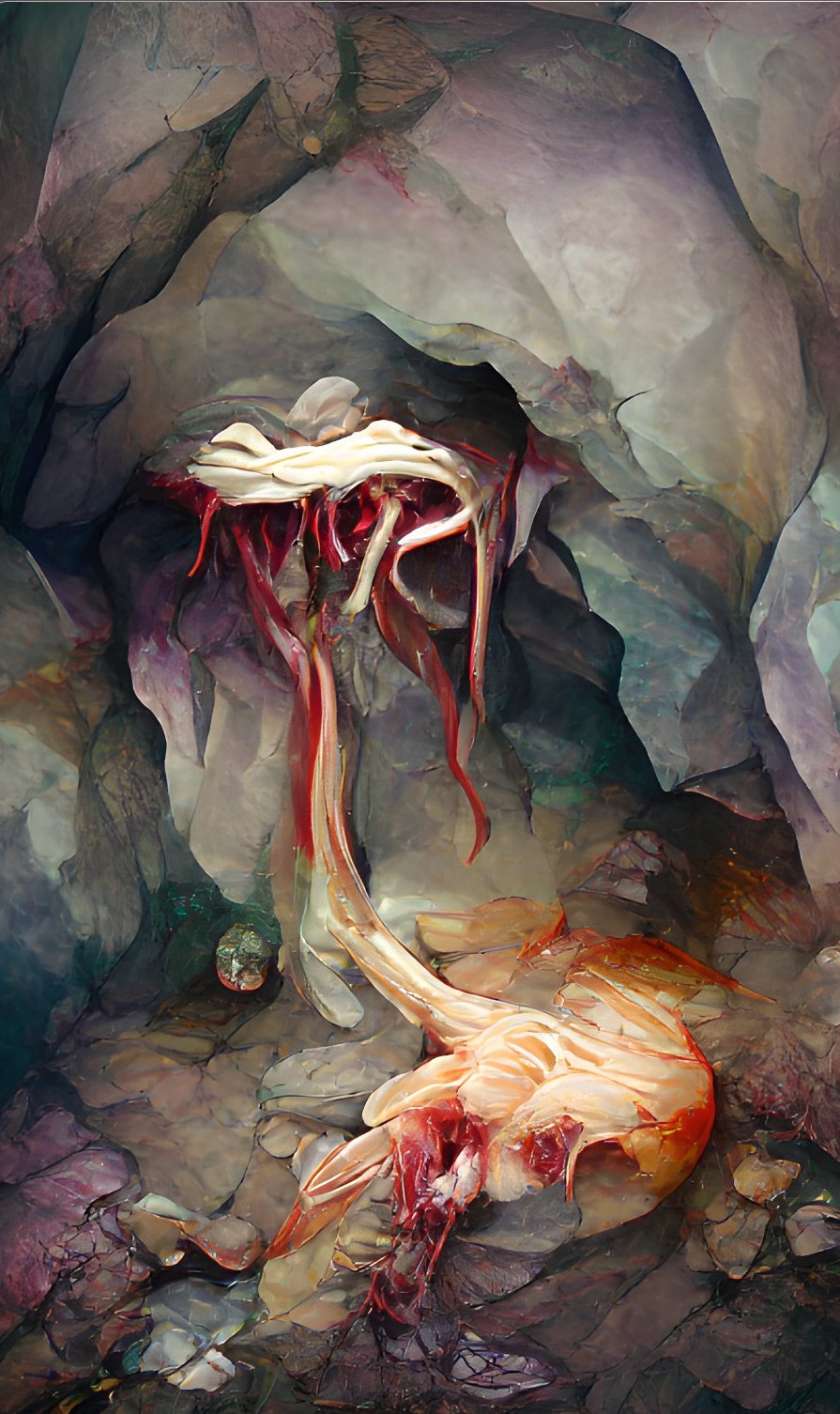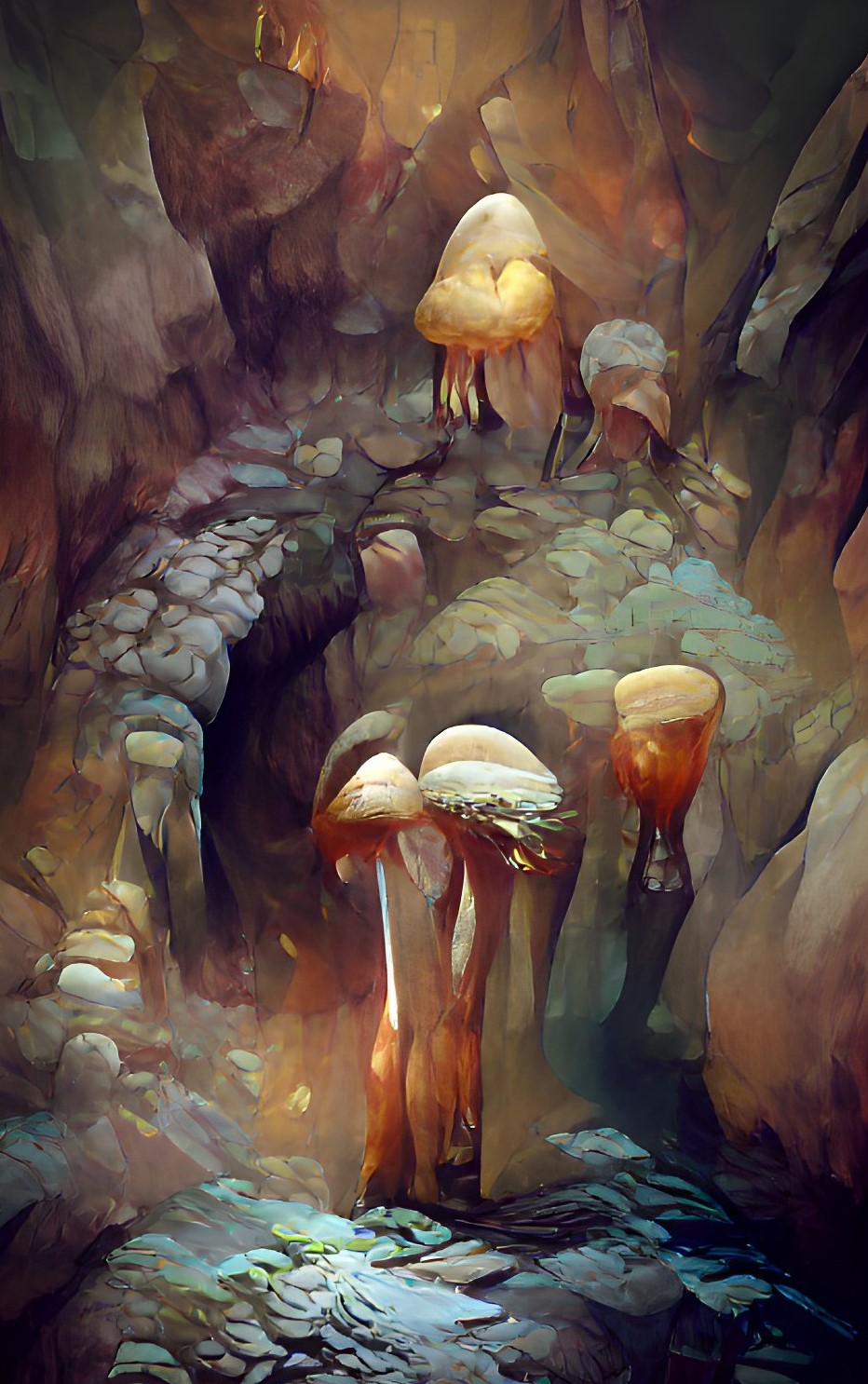Overview
- Government: Religious Magocracy/Meritocracy.
- Exports: Mushroom ale, fungi, quartz and iron tools, gypsum, rodents.
- Stereotypes: Hardy and prideful farmer, fiercely protective of his family; priestess providing experimental fungi treatments; young man who went into priesthood to escape the harsh farm-life; sorceress who ventures into dangerous occult research seeking to advance to Hexe; deathsteed rider that hunts down necromancers.
Foreign Relations
To be expanded.
Origin
Death is a scary thing. People wonder what lies beyond, they fear there is nothing.
As such Death divinities often struggle in terms of popularity. Those who represent some reprieve of death or death inflicted on others can gain decent popularity, but embracing the idea of death itself can be uncomfortable.
Kélet may provide some idea of deeper meaning to a person's death, but the dying and subsequent decay are very front and center. Normally she would have likely remained a minor divinity, if it weren't for the
Chaos Wars. The subsequent
Retreat to the Downside afterwards brought her a great many followers who were both looking for any safe haven in these terrible times, and were also more accustomed to death and suffering already.
Many of these refugees had lost people, and some of the ideas of Kélet brought them solace. The idea that all life eventually returns to the same collective state can be strangely comforting to some who suffer grief. But that is just the early stages. Short-term belief does not build a society, but people adapted over time. Some struggled with the dogma of the Putrid Mother and left or fell by the tunnel-side, while others thrived.
Kélet's knowledge of fungi and decay brought them great advantages such as fermented foods, brining and even some medicine. These things are still poorly understood and mostly explained by people in terms of good and evil spirits, and Kélet understands these things too intimately to describe them more properly in terms that are understandable for people. But even without understanding people can still benefit, and trial and error brings up its own results from time to time.
A society has sprouted, based on studying the fundamental transformative processes of nature and harnessing them to carve out a living in these dangerous lands. They may be called plaguebringers or witches by others, but the kélemeni know that what they are doing is right. Their pursuits are guided by the divine and the results speak for themselves. In time they will find a way to live in harmony with even death.
Structure
The nearby caverns contain multiple iron veins, which has allowed for the production of some basic tools. With these the kélemeni have carved houses and other buildings into the cavern walls surrounding Kélet's hallow. Generally these are very basic crude shapes with simple open rooms and no doors, to promote openness and community. But working stone is difficult, so most houses in the outer ring are simple huts made of
lebegomba stalks. Expansive stone constructions are reserved for important buildings like the temple to Kélet.
Occasionally houses will have a thatched roof of fungus stalks, but this is mostly reserved for the outer ring where aerial predators sometimes sneak in. Sometimes large
izzagomba caps are used to top buildings or provide a second floor. Of course they no longer glow when dead. On many of the mushroom farms, people live under a larger individual fungus that they maintain for that particular reason.
Culture
Kélet's dogma has a significant influence on her followers, as it is with all of the divine cities. The idea of a collective whole permeates her society, and has placed significant focus on traditional family values.
People have also learned that while the idea of death may still be scary, what happens after is a simple part of nature and ought to be acknowledged as it is. Even after death our bodies still contribute to the cycle, and for this reason many refuse burial and prefer to be left outside exposed to the elements where they can complete the transformative process. In their attempts to understand these processes they have also gained invaluable knowledge about fermenting food, or
fungi that can ward off evil spirits to treat disease.
Most people's lives here revolve around the cultivation and harvest of the various types of mushrooms on the fungi farms. It is tough work and food is scarce, which has led to a hardy, no-nonsense type of people. It is expected that everyone in the family carries their weight, and works when work needs to be done rather than argue over who should do it this time. And there is pride in working hard and being willing to get your hands dirty. If someone from a poorer family does not want to work to earn their keep, they are easily shunned.
Politics
In contrast to the large working class of farmers stands the priesthood of Kélet. They are entirely focused on studying the natural world and its transformative processes, although their studies tend to center around biology, the arcane and medicine. It is a strongly matriarchal institution where men cannot rise above a certain position, as they are considered too volatile and impetuous in a decision-making as a result of their biological role.
This also has extensive consequences for the city's leadership, as that is tied to the priesthood. Such a thing is not uncommon within the divine cities, as recognition by a divinity can also be viewed as a divine right to rule depending on one's perspective. The highest ranking members are the Hexe. To ascend to this position they have gone through years of service, extensive research and they have to have brought forth a significant advancement in a particular field of study, for example a cure for a particularly dangerous disease. They lead all religious ceremonies, form the council by which the city operates and they are nearly revered by some people as their research has often saved many lives.
Interestingly enough, the Hexe live by a vow of chastity. Not out of any ideal of purity, but rather to avoid motherhood and the distractions that would bring which would hinder them in their capabilities. Some do end up pursuing motherhood out of personal desire, but they do so after retiring from their position. They are shunned by the
Wolf-Kin for this very reason, as they consider it blasphemous to shun the gift of fertility and motherhood in favor of pursuing positions of power or magical capabilities.
Food and Farming
Most of the nearby land that is not just cold, hard rock is dedicated to the mushroom farms.
Usually a family owns a small plot on land where they grow a variety of types, from izzágomba or 'glow fungus' for lighting, to lebegomba or 'floating fungus' for building material, or a variety of edible types. There is plenty of gypsum nearby which is used as fertilizer along rotting plant or animal matter that is of no use (sometimes even the corpse of a family member who indicated their desire to be left outside exposed to the elements). Between the fungi, fertilizer and the general lack of cleanliness, the place stinks like hell.
To add some variety, grubs and maggots are raised to introduce some meat into the diet, and some of the middle class manage to keep rodents or bats as a delicacy. More commonly though, they herd insects to spice up their diet. Very rarely people may find fruits or other plants hanging from the ceiling on a foray. The favorite local dish is without a doubt mushroom stuffed with smaller chunks of other fungi or insects. For a more rare occasion an insect roast pot is the typical celebratory dish.
The various different fungi can also be used to brew mushroom ale. One or several different types of mushrooms are roasted and then fermented together, producing a savory drink with deep, complex notes. They are not attractive to look at, and the smell can be somewhat off-putting, but when done well the taste is sublime. There are many different brews, and often families that can afford to brew some will have their own special recipes, as varied as the fungi that it is drawn from.
Clothing and Tools
There are many large types of fungi spread around the Downside, and the kélemeni grow a variety of them. But not only the large fruits themselves are useful, so is the mycelium that lies below. In certain cases these can grow into large mat-like structures that can be treated similar to leather. The kélemeni have learned to craft simple items of clothing from this. Generally this 'mushroom leather' is similar in texture to leather itself, and comes in pale colors similar to the fungi themselves. Some of the kélemeni 'paint' their clothes by rubbing certain mosses on it, generally with some symbol that represents their status or family.
As already mentioned, the plentiful nearby iron veins have been mined some basic forge techniques have been developed to craft simple tools like pickaxes or mauls. The forges are usually located near Lake Algávíz which lies directly next to Kélemenedék. They use bellows made from lebegomba balls which are flexible and tough.
There are also some quartz veins nearby, and the mined quartz has been used for a variety of purposes. It can be used for basic cutting tools, or as a decorative stone in houses or temples.
Organizations
Most people spend all of their time taking care of their farms and have no time to band together for any other purposes, but there are some among the middle and upper class or the priesthood that have formed groups to pursue their own specific interests, grow their own influence, or oppose others that they may disagree with.
Arcane Eye Council
Nature has provided us many tools, but they are limited. All the Hexe as well as most other high-ranking members of the faith of Kélet have studied the arcane to some extent. As such this movement can be considered a majority or generally accepted. The idea is of course that using arcane forces along with the tools and medicine already available allows for much greater advancement. The difficulty lies in recognizing where the divide between useful and potentially dangerous lies. There are many great occult forces about that are far too dangerous or malicious to be used. Thus the arkánorvos tries to identify which can be of help and which should be limited or forbidden in use.
Vériga Blood Cult
One such controversial force is the use of blood magic. The vériga movement beliefs that a person's energy is found in their blood, and that by draining or somehow affecting the blood almost any disease or condition could be cured. Perhaps even better, by introducing occult forces to the blood a person could be strengthened. But this is a dangerous field, and the implications of being able to manipulate blood are massive. As such they have to strongly limit what ideas they discuss in public, and keep the more extremist research well-hidden. Even then they still find many opposing voices, and most people strongly distrust them. To most commoners it is a mystery why the Hexe still haven't cracked down on them, even if the leader is one of the Hexe.
Knowledge for All Initiative
The Tudaminden (lit. 'Knowledge for All') Initiative is an action group started by some of the upper and middle class families who feel that the faith of Kélet and the Hexe have far too much power, and keep too much of their work a secret. They advocate for more openness about the research that the Hexe do, and they even wish to install a tribunal of commoners (of appropriate influence class of course) that would review and approve their work before it can be put into practice. They have started a fearmongering campaign by spreading word among the people that the Hexe perform terrible and inhumane experiments on the poor, and they even introduce diseases in the population on purpose to test potential cures.
Necrohunters
Deathsteeds choose who they consider worthy, and often these are warriors of both great skill and integrity. It is not surprising that the deathsteed cavalry form an important and respected part of the faith's military prowess. A particular group amongst them known as the nekrovadász (lit. 'necrohunters'), hunt down those who would disturb the natural cycle of life for their own gain or to study death more closely. Their speed and skill combined means that few would even dare pursue the path of necromancy and incur their wrath.





Comments